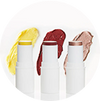How to Refill Your Cup in 5 Steps
How to Refill Your Cup
in 5 Steps
Whether for kids, grandkids, spouses, parents, friends or neighbors, women are often caregivers. We work hard inside and outside the home. That doesn’t stop with an empty nest or even retirement.
Women keep the world running. That’s why it's vitally important that we take good care of ourselves before caring for others.
Learning how to refill your cup feels good, makes you more resilient and allows you to give from a place of abundance. It’s vital for keeping your body strong—for yourself as well as those who love and depend on you.
But if you’re in the habit of giving until you collapse, learning how to refill your cup before it’s empty might feel like a tall order—but we have a few ideas to help.
For our five steps to greater resilience, health and peace of mind, read on...
1. Tune in.
If you’re not used to thinking about yourself, knowing what's in the tank can be a challenge in itself. So take a moment right now to tune in to your body and notice how it feels.
For example, you may feel: light or heavy, energetic or fatigued, peaceful or restless.
Then, use what you feel to determine what your body needs. If you feel fatigued or heavy, do you may need sleep, exercise, healthy food, more water? Are you feeling restless or anxious? Maybe it's time for some meditation or deep breathing,
Make it a regular practice to focus inward and see what’s going on. Then, make a plan to fulfill your unmet needs.
2. Learn what works for you.
There is so much (often conflicting) health and wellness information out there. But what you do is beneficial only if it works for you. Rather than just accepting what someone else has labeled "healthy", take time to determine what works best for you.
Take five minutes to reflect on times you’ve felt especially rested, refreshed and rejuvenated. Then, get really specific: If the most refreshed and relaxed you’ve ever felt was on your beach vacation—, what about that experience was so relaxing?
Maybe it was sipping coffee on your balcony. Or listening to the waves as you drifted off to sleep. Whatever the experience, zero in on what left you feeling refreshed, relaxed or energized.
Now, consider how you can bring those experiences into your daily life. Perhaps you can’t go to the beach right now… but you can listen to recorded ocean sounds as you fall asleep.
With time and practice, you’ll gain awareness of what works for you and build those experiences into your life to help you relax and recharge.
3. Consider ALL your needs.
It’s important to consider all of your needs: physical, mental, social, emotional and spiritual.
Physical needs can include exercise, a healthy diet, drinking water, getting plenty of sleep or caring for your skin or hair.
Caring for your mental health might look like scheduling alone time, reducing your workload or limiting social media, while spiritual needs might include mindfulness or connecting with nature.
Some of your needs may overlap multiple categories. For example, some women find that running benefits their physical and mental health.
You might prioritize one category over another when it's most needed in the moment. But once an urgent need is met, don’t neglect the rest.
4. Schedule it.
If you’re not used to caring for yourself, you’re more likely to skip self-care unless it’s on the calendar.
If your cup feels full after time with friends, don’t casually agree to get together—set a date, time and location. If self-care for you means extra sleep, reset your alarm and let your partner know so they can support your sleeping in.
Try not to put off self-care you could do immediately. If a bath sounds relaxing and refreshing, don’t wait—do it now (or put it on tonight's agenda).
Keep in mind that self-care time is not multitasking time. Focus on the present moment—don’t worry about the future or even think about what comes next.
Of course, if your plan doesn’t work out for any reason, be kind, flexible and gentle with yourself—and reschedule like you would with a good friend.
5. Don’t stop when you feel better.
We have a tendency to stop doing the things that make us feel good the instant we feel better. But feeling better is a sign you’re on the right track, not a sign to stop.
Letting your tank run down to empty can impact your overall health. Instead, make a plan to continually refuel well before your needle points to “E.”
If you struggle to follow through on your self-care plans, consider asking a spouse, friend or family member to help. Regular check-ins can help you stay on track—and may inspire their own self-care as well!
Most importantly of all, try not to let self-care become another chore on your to-do list. Give yourself lots of grace as you learn to treat yourself with the same care you show others.
And remember: Regardless of your accomplishments, contributions or productivity, you are worthy of love and attention. Please take care of yourself.
How do you know when your cup is low? How do you refill it?
CHECK OUT OUR MOST POPULAR CONTENT
































